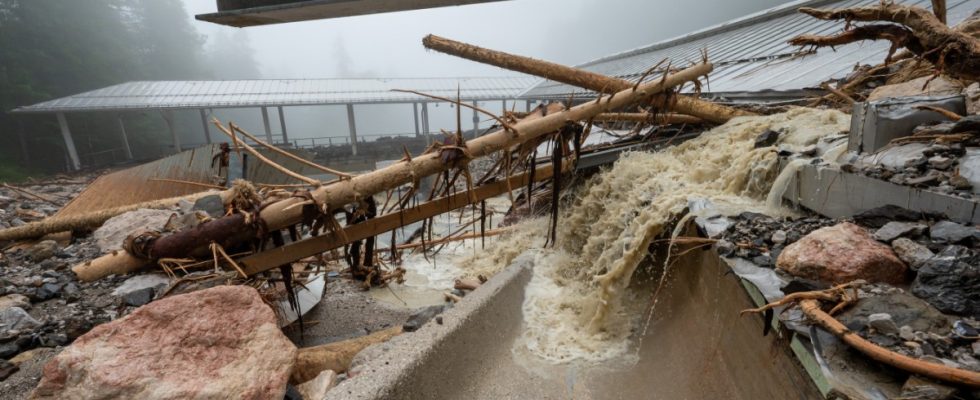In his career as a luger, Alexander Resch has secured four world championship titles and one Olympic victory in doubles with Patric Leitner. Back then, it wasn’t just every hundredth of a second that mattered, but every thousandth. Now, two decades later and as an official in the Bobsleigh and Sled Association for Germany (BSD), the Berchtesgadener “of course the timeline is much too long”. But it doesn’t help: His home track, the famous bobsleigh track on Königssee, belongs to the Berchtesgadener Land district, and they need time for a project of this dimension. On Friday, the district council approved the preliminary drafts for the reconstruction of the ice track with a large majority. Races will not be able to take place there again until the end of 2025 at the earliest.
Most people and local politicians in the Berchtesgaden valley basin knew from the start that the prestigious track absolutely had to be rebuilt, because it has long since become part of their identity as a top sports region. Even high politics never left any doubts about the reconstruction. The very day after the destruction, Prime Minister Markus Söder and then Federal Finance Minister Olaf Scholz went to Königssee and promised help. Three months later, the district council commissioned plans for how the railway could be rebuilt and protected against similar events. The federal government is providing 53.5 million euros for this, the money comes from the aid pot after the flood disaster of 2021, which caused far greater damage in the Ahr Valley than in and around Berchtesgaden.
But the project is not completely undisputed, even under the Watzmann. Above all, the nature conservation associations Bund Naturschutz (BN) and Landesbund für Vogelschutz (LBV) are critical, in the district council the ÖDP and parts of the Greens. “53 million isn’t long at the front or the back,” says BN district chair Rita Poser, for example. The district does not want to spend more than it gets from the federal government. But the fact that the cost estimate, which the district council approved with the plans on Friday, is exactly within this framework is also due to the fact that large parts of the new Klingerbach obstruction, which is intended to hold back driftwood and debris in the future, are funded from other pots.
In 2021, the creek had washed up the masses of wood, stone and mud, which then jammed and dammed up at the very bridge where the bobsled crossed the creek. While this may have saved some homes further down the creek from the worst, the mudslides spilled into the track, taking parts with them. The prospect that something like this could happen again at any time is the main criticism of conservationists. The planned fences and barriers, as well as the fact that the track will no longer cross the creek in the future, but that the start for the lugers will remain on the southern side, do not calm the critics in any way.
Where the starting section for the tobogganists used to cross the Klingerbach, a bed load barrier is to hold back the washed-up material in the future. The start for the tobogganists will then be above the starting house for the bobsleigh and skeleton competitions and, after a tight first curve, will lead to the next section of the ice tube.
(Photo: Landratsamt Berchtesgadener Land/Editing: SZ)
“We are concerned about the georisks,” says LBV district chairman Toni Wegscheider. The entire rink was built from the start on a pile of alluvial debris, at the end of the 1950s as a natural ice rink, ten years later as the world’s first artificial ice rink. According to the official risk maps, there is still a lot of material on the flanks of the Grünstein above the railway that can eventually slide down the valley – and then possibly sweep the railway with it again. In any case, Poser and Wegscheider consider it questionable to spend so many millions in taxes on a “niche sport” under these circumstances. Poser expressly reserves the right to sue the BN as soon as the final district council resolution on the plans that have been drawn up has been passed in October and the associations have to be officially heard and informed in detail.
Because even the energy-intensive cooling can hardly be justified for the conservationists in times of climate change – especially since little or nothing will be left of the 53 million euros to make the operation climate-neutral in the future. Nevertheless, the bobsleigh and sled association is sticking to its declared goal of producing as much energy over the year as the track consumes. The railway buildings are less suitable for photovoltaics because of their shady location, but Alexander Resch says he is negotiating with possible partners and sponsors about systems that could produce solar power on public areas elsewhere in the valley.
At the same time, the association is working internationally to ensure that the season does not start until November in order to save cooling energy. The Königssee track is one of the more than a dozen international competition venues in this area worldwide. The fact that some tracks have been abandoned in recent years confirms both the critics and the advocates of reconstruction. Because for them, the Eiskanal am Königssee is only gaining in importance.

